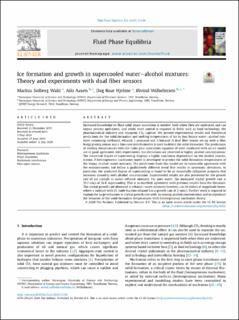| dc.contributor.author | Wahl, Markus Solberg | |
| dc.contributor.author | Aasen, Ailo | |
| dc.contributor.author | Hjelme, Dag Roar | |
| dc.contributor.author | Wilhelmsen, Øivind | |
| dc.date.accessioned | 2020-08-19T09:29:20Z | |
| dc.date.available | 2020-08-19T09:29:20Z | |
| dc.date.created | 2020-06-26T08:22:38Z | |
| dc.date.issued | 2020 | |
| dc.identifier.citation | Fluid Phase Equilibria. 2020, 522, | en_US |
| dc.identifier.issn | 0378-3812 | |
| dc.identifier.uri | https://hdl.handle.net/11250/2672951 | |
| dc.description.abstract | Increased knowledge on fluid-solid phase transitions is needed, both when they are undesired and can impair processes operation, and when strict control is required in fields such as food technology, the pharmaceutical industry and cryogenic CO2 capture. We present experimental results and theoretical predictions for the solid-formation and melting temperatures of ice in four binary water–alcohol mixtures containing methanol, ethanol, 1-propanol and 1-butanol. A dual fiber sensor set-up with a fiber Bragg grating sensor and a thin-core interferometer is used to detect the solid-formation. The predictions of melting temperatures with the cubic plus association equation of state combined with an ice model are in good agreement with experiments, but deviations are observed at higher alcohol concentrations. The measured degree of supercooling displays a highly non-linear dependence on the alcohol concentration. A heterogeneous nucleation model is developed to predict the solid-formation temperatures of the binary alcohol–water mixtures. The predictions from this model are in reasonable agreement with the measurements, but follow a qualitatively different trend that results in systematic deviations. In particular, the predicted degree of supercooling is found to be an essentially colligative property that increases smoothly with alcohol concentration. Experimental results are also presented for the growth rate of ice crystals in water–ethanol mixtures. For pure water, the measured crystal growth rate is 10.2 cm/s at 16 K supercooling. This is in excellent agreement with previous results from the literature. The crystal growth rate observed in ethanol–water mixtures however, can be orders of magnitude lower, where a mixture with 2% mole fraction ethanol has a growth rate of 2 mm/s. Further work is required to explain the large reduction in crystal growth rate with increasing alcohol concentration and to reproduce the behavior of the solid-formation temperatures with heterogeneous nucleation theory. | en_US |
| dc.language.iso | eng | en_US |
| dc.publisher | Elsevier | en_US |
| dc.rights | Navngivelse 4.0 Internasjonal | * |
| dc.rights.uri | http://creativecommons.org/licenses/by/4.0/deed.no | * |
| dc.title | Ice formation and growth in supercooled water–alcohol mixtures: Theory and experiments with dual fiber sensors | en_US |
| dc.type | Peer reviewed | en_US |
| dc.type | Journal article | en_US |
| dc.description.version | publishedVersion | en_US |
| dc.source.volume | 522 | en_US |
| dc.source.journal | Fluid Phase Equilibria | en_US |
| dc.identifier.doi | 10.1016/j.fluid.2020.112741 | |
| dc.identifier.cristin | 1817210 | |
| dc.description.localcode | This is an open access article distributed under the terms of the Creative Commons CC-BY license, which permits unrestricted use, distribution, and reproduction in any medium, provided the original work is properly cited. | en_US |
| cristin.ispublished | true | |
| cristin.fulltext | original | |
| cristin.qualitycode | 2 | |

